Drop C is one of the most common alternate bass tunings. This comes as no surprise, as the tuning can be incredibly versatile, heavy, and powerful when used to its full potential.
Therefore, I`ve decided to show you how to easily tune both a 4-string and a 5-string to Drop C. There is even a tuner further down in this article that you are free to use.
I will also show you some things you should be mindful of before tuning down. This way you will know what strings to opt for, and how to set up your bass for the tuning.
We will take a look at the strengths of Drop C and why bands choose it over other tunings. I`ve also thrown in a list of songs from various bands that are played in Drop C for inspiration.
What is Drop C used for?
Drop C is a common alternate tuning, but why is that? Here are some of the main reasons that bass players tune down to C, and why they choose it over other tunings:
Power and heaviness
There is a good reason that most bands that tune to Drop C play sub-genres of metal.
It`s a heavy and powerful tuning that allows you to play deep and hard-hitting bass grooves. Given that the bass is already playing in a low register, 2 more whole notes of deep range create a world of difference in how heavy you will sound.
Accommodating vocalists
Some vocalists have a deep vocal range. Some also lose some of their range as they grow older. In these cases, it can be helpful for the band to tune down their instruments to make the job of the vocalist easier.
Easier to play power chords
Bass players don`t tend to play a lot of power chords. For metal and hard rock guitarists though, it`s their bread and butter.
Drop C allows deep power chords to be played with just one finger, instead of two, which is significantly easier. This is because the C and G strings are tuned a 5th apart, instead of a 4th.
In turn, bassists often tune to drop C, because it is convenient for all the members of a band to play in the same tuning.
Middle ground
Both Eb standard and A standard, are tunings that can make a band sound heavier. However, Eb standard might not provide enough of a noticeable difference when compared to E standard.
A standard on the other hand can sound excessively deep. Therefore, many bands go for something in between, with Drop C being a great middle ground between too much and too little.

Setting a bass up for drop C
Switching to a different tuning requires you to do more than just tuning your bass. A lower tuning means the strings, neck, and nut of your bass will face a new level of tension.
Therefore, be mindful of the following when tuning to drop C:
- High action – When you tune down, the action on your bass is likely to increase. This is a result of the tension that is put on the neck of the bass. If you prefer lower action, this can adjusted with a truss rodd adjustment.
- Intonation – The intonation on your bass could become slightly off when you switch tuning and strings. This means that fretted notes are not perfectly on pitch, even when you are in tune. This is usually more noticable at higher frets. You can adjust the intonation on your bass if this happens.
- String choice – Different tunings require different strings. Using strings that are too thin for Drop C will result in them sounding clicky, unresonant and weak. I go more in-depth about string choice lower in this article, where I explain why I recommend this .120 D`Addario set for drop C.
- Staying in tune – When permanently changing to a different tuning, your bass will take some time to adjust to it. As a result, your bass will detune faster and you will need to tune it more often. This is normal, and the need to tune will become less freqcuent with time.
- The nut – Depending on string choice and the filings on the nut of your bass, your new strings might not fit into it properly. If this happens, you will need to file the cuts in the the nut to better fit the new strings. Drop C is a borderline tuning where it is a close call wheter this will be necseassry.
All of this can be adjusted on your own. Alternatively, you can get a luthier to do it for you if you want to ensure that your bass gets set up correctly.
How do I tune my bass to drop C?
Your bass can be tuned to drop C by tuning the strings to CGCF for 4-string basses, and CGCFA for 5-string basses. This can be done with the help of a physical or an online tuner, or by ear using a different instrument.
To make things easy for you, I made a Drop C tuner. Tune the strings to the same pitch that is played below, going from deepest to highest:
C (deepest string):
G:
C:
F:
A (for 5-strings):
If you find it difficult to hear whether your strings are in tune with the tuner above, I recommend using a chromatic tuner instead. I`ve used this chromatic tuner for a while now for tuning both my bass and guitar. It shows you the exact pitch that is being played, meaning you can be 100% sure you are tuned to drop C.
You can also tune your bass with an online tuner through a microphone. It might struggle to pick up the lowest frequencies though. If this happens, fret the string you are trying to tune at the 12th fret, as it will be easier for the microphone to pick up. This is the octave and should be the same note as the open string.
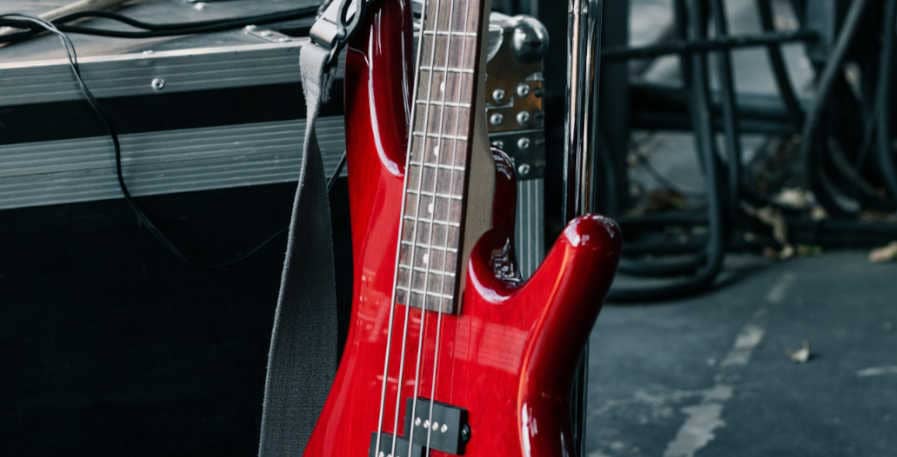
What gauge strings should I use for Drop C?
A balanced set of strings for bass guitars tuned to drop C is .120-.090-.070-.050, with an added .035 for 5-strings. Depending on tonal preference, the low C string can be changed to gauges in the .130 to .115 range.
If you currently have a set of strings intended for E standard, such as .105-.050, they will sound suboptimal in Drop C.
The strings will be loose and sound clanky, which will negatively impact both playability and tone. This will be especially noticeable when playing your heaviest string. This is because it is tuned down 2 whole notes, and deeper pitches quickly lose resonance if the string is too thin.
While Ernie Ball recommends .110 for D standard and Drop C, every bassist I`ve talked to about this has found this to be too thin for Drop C.
I prefer .120 personally, but everything from .130 to .115 are viable gauges that will be playable and resonant. A heavier gauge can sound more powerful but will also have higher tension which can affect playability.
Thus, if you are looking to play a heavy genre, I recommend this .120-.050 set from D’Addario. In Drop C it strikes a nice balance which makes your tone heavy and resonant while retaining the playability of your instrument.
What songs use Drop C tuning?
Drop C is mainly used in various subgenres of metal. It is one of the most common alternate tunings in metal, and the only tuning that I have seen used more is Drop D.
You will find that a lot of metalcore, post-hardcore, and alternative metal acts write music in this tuning. Drop C is thus a big part of the staple sound of these genres.
Below are 10 bands and some of their notable songs that are played in Drop C. Many of these bands have changed their sound throughout their career, and their genres can be hard to pinpoint. The information below is intended to give a surface-level glimpse into what type of music these bands play:
| Band | Bassist | Genre | Notable songs in Drop C |
| Mastodon | Troy Sanders | Sludge Metal | Oblivion, Show Yourself |
| Gojira | Jean-Michel Labadie | Groove Metal | Lenfant Sauvage, Vacuity |
| Killswitch Engage | Mike D’Antonio | Metalcore | Holy Diver, My Curse |
| System Of A Down | Shavo Odadjian | Alternative Metal | Chop Suey, Aerials |
| Deftones | Chi Cheng (1990-2008), Sergio Vega (since 2009) | Alternative Metal | Change In The House Of Flies, Digital Bath |
| Escape The Fate | Erik Jensen (Touring only) | Post-hardcore, Metalcore | My Apocalypse, Not Good Enough For Truth In Cliche |
| As I Lay Dying | Josh Gilbert | Metalcore | The Darkest Nights, Confined |
| Falling in Reverse | Wes Horton III (since 2021) | Multiple genres, Post-hardcore, Metalcore | The Drug In Me Is You, Alone |
| Periphery | None, Adam Getgood til 2017 | Djent | Absolomb, Sentient Glow |
| Skillet | John Cooper | Metal, Hard Rock | Monster, Awake And Alive |
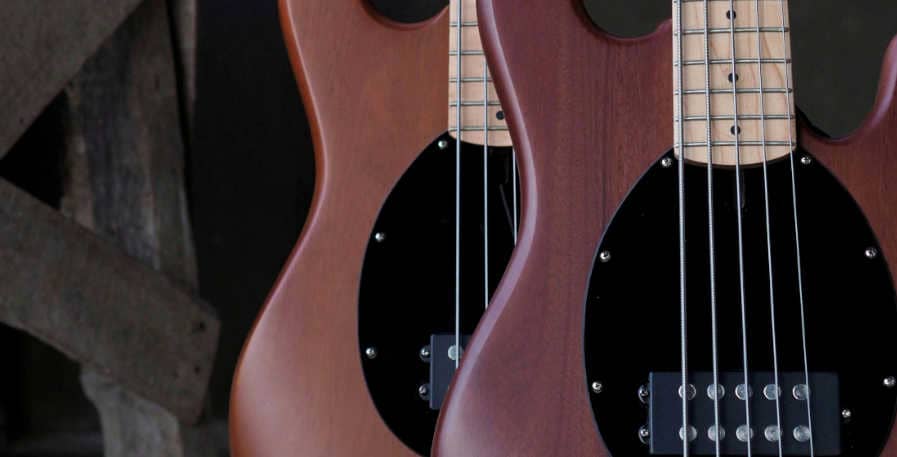
What is drop C tuning on a 5 string bass?
A 5-string bass can be tuned up to C-G-C-F-A for a Drop C tuning. Alternatively, the bass can be kept in B standard if you don`t need an open C string. Other options include ACGCF to emulate a 4-string bass while having some deeper tonal reach, or CEADG for ease of use.
While tuning a bass up is less common, it is perfectly possible to do so if you want to tune your 5-string to Drop C. However, before doing so it`s best to assess why you are looking to tune drop C in the first place.
First of all, will you rely heavily on the open C string to play the type of music you want? If not, basslines like the one below can be played equally well in B standard as in drop C:
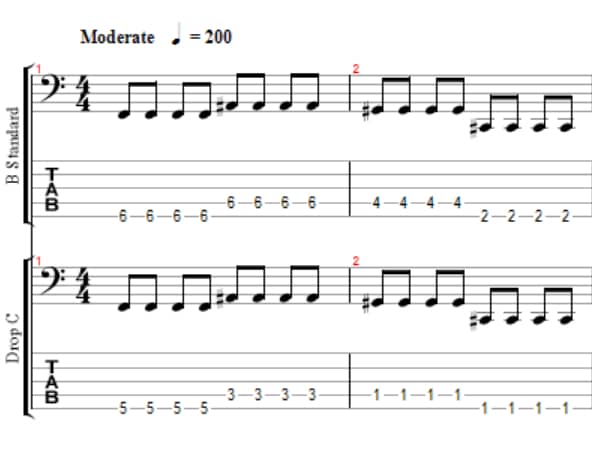
It`s not uncommon for metal riffs to rely on playing an open string though. Riffs like this are going to be a lot more cumbersome to play in B standard than drop C:
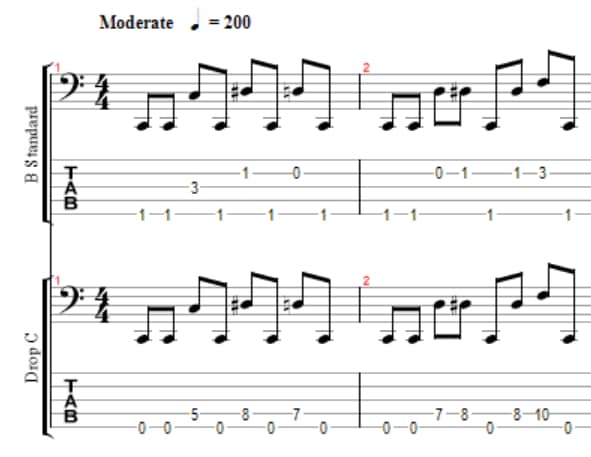
If you need to play riffs similar to this one, my best advice is to tune your 5-string up to drop C.
For those of you who don`t want to tune up your whole bass, but need an open C, I recommend tuning to CEADG.
While this creates an awkward major 3rd interval between the C and E, it is also very easy to switch between this tuning and B standard. You only need to tune your deepest string half a step, which also means you can use the same strings as in B standard.
Drop C vs C Standard for bass
In Drop C the deepest string is tuned two whole steps and the rest of the strings 1 whole step down to C-G-C-F. In C standard every string is tuned 2 whole steps down to C-F-D#-A#.
These two tunings have the same deep range, but C standard has 1 whole note of higher range. This will rarely matter, and the difference between Drop and Standard is mainly about playability.
Riffs that utilize multiple strings have to be played differently in Drop and C standard. This will rarely make a riff noticeably harder:
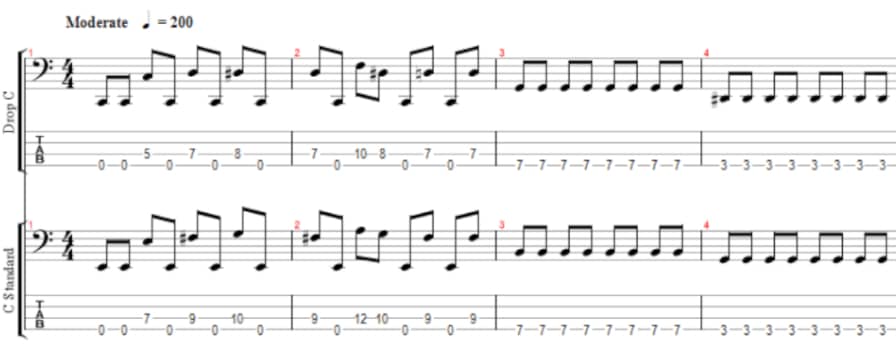
If, however, a riff utilizes an open string that is not the C, it will change quite a bit between the two tunings. A riff written in Drop C, could thus become convoluted to play in C standard:
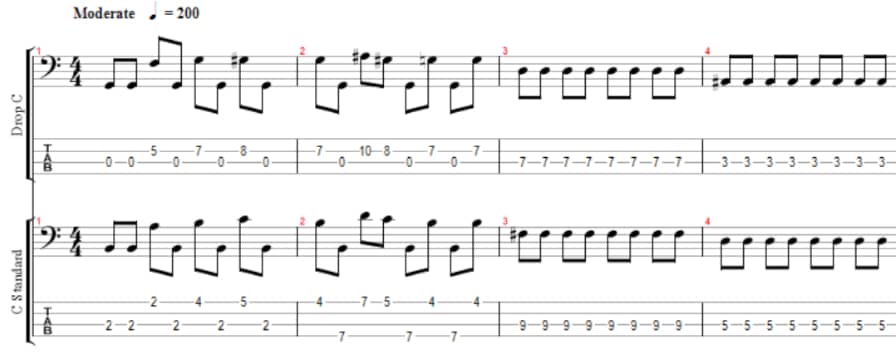
Guitarists often prefer Drop C over C Standard because it allows them to play power chords easier. In a band, this could indirectly impact you. While you don`t have to play in the same tuning as the guitar players, it generally makes things easier to do so.
When everyone is playing in the same tuning you don`t have to transpose or rework riffs. You also avoid awkward fingering patterns as in the example above.
The benefit of playing in C standard over Drop C is that standard tunings will feel easier. If you are used to playing in E standard, all your muscle memory and knowledge of intervals can be applied in C standard as well.
Thus, whether you opt for C standard or Drop C mainly depends on three things.
- 1. Band tuning – Do you need to play in the same tuning as the guitarists in a band, and which tuning will suit you both the best?
- 2. Covers – Are you looking to cover artists that play in either Drop C or C standard? I highly recommend using the same tuning as the bands that you are looking to cover. Transposing whole songs to a different tuning can be time-consuming and make riffs harder to play.
- 3. Open string riffs – Will you be writing and playing riffs that utelize open strings a lot? Riffs that do so will feel different between the tunings, especially when played on other open strings than the C.
Conclusion
If you`re a metal or hard rock bassist, chances are good that you will tune your bass to drop C at some point. It is a common alternate tuning that many bands opt for, despite it requiring more setup than Drop D.
There are two main things you should do if you are gonna try out drop C. First, get a heavy set of strings, and get your bass set up properly for the new tuning. Second, familiarize yourself with the fretboard, and get used to the C and G string being a perfect fifth apart.
If you do that, playing in Drop C won`t feel much different than playing in E standard. The playability of your bass will feel slightly different due to the thicker strings and difference in tension. However, it doesn`t take too long to get used to it. Most importantly, your sound will also be a lot heavier.
If Drop C sounds fitting for your band, or for you as a solo bassist, use the information in this article to get started. Drop C is one of the most common alternate bass tunings for a good reason, and it will allow you to write some incredibly hard-hitting grooves in no time.
An often overlooked aspect of switching bass strings is how they should be wrapped around the tuning pegs. Therefore, I`ve written a guide on how many times you should wrap bass strings.

